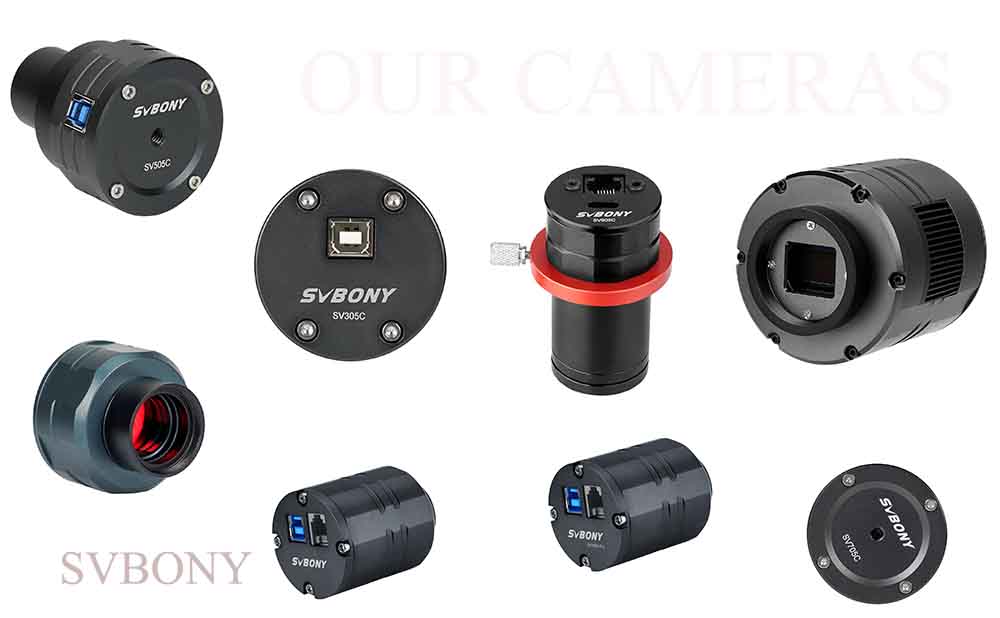Comparison and Summary of Our Cameras

Comparison and Summary of Our Cameras
When you are choosing an astronomical camera, you may need to focus on the following main parameters:
Pixel Size: Pixel size refers to the physical size of each pixel on the camera's image sensor. Larger pixels can capture more photons, helping to improve image quality and signal-to-noise ratio.
Pixel Count: Pixel count represents the total number of pixels on the camera's image sensor. Higher pixel count provides higher resolution and better detail-capturing ability.
Dynamic Range: Dynamic range refers to the range of brightness that the camera can capture. A larger dynamic range allows for the retention of more bright details in the same image, avoiding overexposure or underexposure.
Quantum Efficiency: Quantum efficiency is the sensitivity of the camera to photons, i.e., the efficiency of converting photons into electrical signals. Higher quantum efficiency means that the camera can better capture details under low light conditions.
Noise Reduction: Noise reduction refers to the built-in noise reduction techniques and algorithms in the camera, which help reduce noise in the image and improve image quality.
Exposure Time Range: Exposure time range indicates the shortest and longest exposure time that the camera can be set to. A wide exposure time range allows the camera to adapt to different observational conditions, including low-light and high-light environments.
Cooling System: The cooling system lowers the temperature of the camera sensor, reducing thermal noise and improving image quality. Common cooling systems include fan cooling and thermoelectric cooling (TEC).
With the continuous upgrading and updating of our cameras, now we have developed different cameras in both planetary and deepspace astrophotography, including color cameras and mono cameras. We also summarize all main parameter information about them, which can be used as a reference.
| Model | Image Sensor | Sensor Model | Image Resolution | Pixel Size | Sensor size | Diagonal | USB Type | Exposure Time | ADC |
| SV105C | 1/2.8” CMOS | SONY IMX307 | 2.07 Mega pixels (1920*1080) | 2.9μm X 2.9μm | 5.5mm*3.1mm | 5.7mm | USB2.0 | 15ms-1000ms | 10bit/12bit |
| SV205C | 1/2.8” COMS | SONY IMX415 | 7.05 Mega Pixels (3264*2160) | 1.45μm X 1.45μm | 4.7mm*3.1mm | 5.7mm | USB 3.0 | 15ms-1000ms | 10 bit |
| SV305 | 1/2.8" CMOS | SONY IMX290 | 2 Mega Pixels 1920X1080 | 2.9X2.9μm | 5.5mm*3.1mm | 5.7mm | USB 2.0 | 1ms~30min | 12 bit |
| SV305 Pro | 1/2.8" CMOS | SONY IMX290 | 2MPixels 1920*1080 | 2.9µmx2.9µm | 5.5mm*3.1mm | 5.7mm | USB3.0 | 1ms~30min | 10 bit/12 bit |
| SV305M Pro | 1/2.8” COMS Mono | SONY IMX290 | 2M Pixels (1944*1096) | 2.9μm X 2.9μm | 5.5mm*3.1mm | 6.5mm | USB 3.0 | 0.03ms-2000s | 12bit |
| SV505C | 1 / 1.8" CMOS | SONY IMX464 | 4.2 million pixels(2712×1538 ) | 2.9μm* 2.9μm | 7.9mm×4.5mm | 9mm | USB3.0 | 64us-2000s | 12bit |
| SV705C | 1/1.2” CMOS | SONY IMX585 | 8.3 Mega Pixels(3856×2180) | 2.9μm X 2.9μm | 11.2mm×6.3mm | 12.85mm | USB3.0 | 32μs-2000s | 12 bit |
| SV905C | 1/3” CMOS | SONY IMX225 | 1.2M pixel(1280×960) | 3.75µmx3.75µm | 4.8mm×3.6mm | 6mm | TypeC USB2.0 | 64us~2000s | 12 bit |
| SV405CC | 4/3" CMOS | SONY IMX294 | 11.7 megapixels 4144*2822 | 4.63*4.63μm | 19.2mm*13mm | 23.2mm | USB3.0 | 0.05ms-2000s | 14 bit |
| SV605CC | 1" CMOS | Color IMX533 | 9.0 Megapixel 3008*3008 | 3.76μm x 3.76μm | 11.3mm*11.3mm | 15.968mm | USB3.0 | 0.05ms-2000s | 14bit |
| SV605MC | 1" CMOS | Monochrome IMX533 | 9.0 Megapixel 3008*3008 | 3.76μm(H) x 3.76μm(V) | 11.3mm*11.3mm | 15.968mm | USB3.0 | 32ms-2000s | 14bit |








